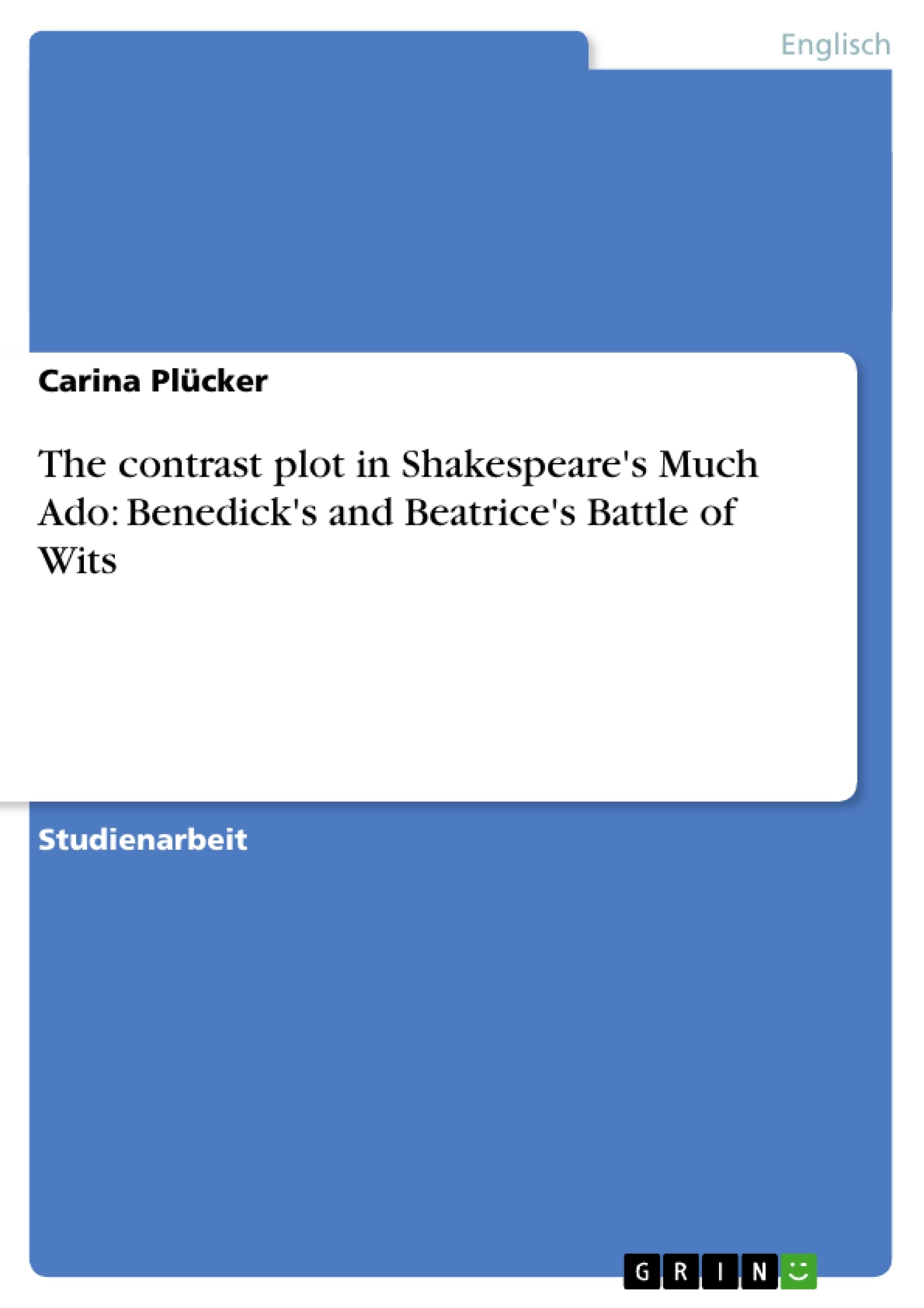Much Ado About Nothing is one of Shakespeare’s early tragic comedies. Written in 1598/99, the play was published in quartos only one year later. In this paper I will tackle a very much-discussed issue, that critics still cannot unanimously agree on. The contrast plot in Much Ado is elaborated in such detail and is thematically so important to the play’s effect on readers and spectators, that the question arises, whether the said-to-be subplot probably functions as the secret main plot in the play. In chapter one, I will start outlining the most important aspects of the context, that the Benedick-Beatrice plot is embedded into. Additionally, I will characterise the two devotees Benedick and Beatrice as a first step to learn more about their behaviour, their thinking and their importance to the plot. The characterisation will only focus on relevant facts, which contribute to the analysis of their witty battles. Chapter 2 deals with the contributions of both Benedick and Beatrice, which they take in their merry war. With the help of text passages, important parts of their witty battles will be analysed. Furthermore, quotations of literary critics committed to the play will be used to examine the motives of both competitors. Finally, the third chapter will be concerned with the central question of this paper. Asking whether Benedick and Beatrice’s battle of wits can be taken as the main plot of Much Ado About Nothing, this section studies the standpoints of various critics As Much Ado About Nothing was written as a play to be performed, and is also read as a literary work, I will facilitate speaking about its addressees. Whenever I mention “readers”, both “readers” at home and “spectators” in the theatre are thought of. [...]
Inhaltsverzeichnis
- Einleitung
- Der Benedick-und-Beatrice-Plot
- Charakterisierung Beatrice
- Charakterisierung Benedick
- Ihr lustiger Krieg
- Benedick und Beatrices Wortgefecht als Hauptplot von Much Ado About Nothing?
Zielsetzung und Themenschwerpunkte
Diese Seminararbeit untersucht die Bedeutung des Nebenplots um Benedick und Beatrice in Shakespeares "Much Ado About Nothing". Es wird der Frage nachgegangen, ob dieser vermeintliche Nebenplot tatsächlich als heimlicher Hauptplot des Stücks fungiert. Die Arbeit analysiert die Charaktere, ihre Interaktionen und die kritische Rezeption dieses Aspekts des Stücks.
- Analyse des Nebenplots um Benedick und Beatrice
- Charakterisierung von Beatrice und Benedick
- Interpretation ihrer Wortgefechte
- Diskussion der Rolle des Plots innerhalb des Gesamtkontexts des Stücks
- Bewertung der kritischen Meinungen zum Thema
Zusammenfassung der Kapitel
Einleitung: Die Einleitung führt in das Thema ein und stellt die zentrale Forschungsfrage nach der Bedeutung des Benedick-und-Beatrice-Plots in Shakespeares "Much Ado About Nothing". Es wird die bereits existierende Debatte unter Literaturwissenschaftlern angesprochen und der methodische Ansatz der Arbeit skizziert. Die Arbeit untersucht, ob der vermeintliche Nebenplot die eigentliche tragende Handlung des Stücks darstellt.
Der Benedick-und-Beatrice-Plot: Dieses Kapitel beleuchtet zunächst den Kontext, in den der Plot eingebettet ist. Anschließend werden die Charaktere Beatrice und Benedick im Detail vorgestellt. Die Charakterisierung konzentriert sich auf Aspekte, die für die Analyse ihrer Wortgefechte relevant sind. Beatrice wird als intelligente, energische und unabhängige Frau dargestellt, während Benedick als ironischer Frauenhasser beschrieben wird, der heimlich nach Liebe und Ehe sehnt. Der Abschnitt bereitet den Boden für die detaillierte Analyse ihrer Interaktionen.
Ihr lustiger Krieg: Dieses Kapitel analysiert die Wortgefechte zwischen Benedick und Beatrice mithilfe von Textauszügen und Kommentaren von Literaturwissenschaftlern. Es werden die Motive der beiden Protagonisten untersucht und ihre Beiträge zu ihrem "lustigen Krieg" beleuchtet. Durch die Analyse der Dialoge wird das komplexe Wechselspiel zwischen Witz, Sarkasmus und unterschwelliger Anziehungskraft der beiden Figuren verdeutlicht, das die Grundlage für die Entwicklung ihrer Beziehung bildet.
Schlüsselwörter
Much Ado About Nothing, Shakespeare, Nebenhandlung, Hauptplot, Benedick, Beatrice, Wortgefecht, Charakterisierung, Ironie, Liebe, Ehe, Unabhängigkeit, Komödie, Literaturkritik.
Häufig gestellte Fragen zu "Much Ado About Nothing": Analyse des Benedick-und-Beatrice-Plots
Was ist der Gegenstand dieser Seminararbeit?
Diese Seminararbeit analysiert die Bedeutung des Nebenplots um Benedick und Beatrice in Shakespeares "Much Ado About Nothing". Die zentrale Forschungsfrage ist, ob dieser vermeintliche Nebenplot tatsächlich als heimlicher Hauptplot des Stücks fungiert.
Welche Aspekte werden in der Arbeit untersucht?
Die Arbeit untersucht die Charaktere Benedick und Beatrice, ihre Interaktionen (insbesondere ihre Wortgefechte), die Interpretation dieser Interaktionen, die Rolle des Plots im Gesamtkontext des Stücks und die kritische Rezeption dieses Aspekts.
Wie werden Benedick und Beatrice charakterisiert?
Beatrice wird als intelligente, energische und unabhängige Frau dargestellt, während Benedick als ironischer Frauenhasser beschrieben wird, der heimlich nach Liebe und Ehe sehnt. Die Charakterisierung konzentriert sich auf Aspekte, die für die Analyse ihrer Wortgefechte relevant sind.
Wie wird der "lustige Krieg" zwischen Benedick und Beatrice analysiert?
Der "lustige Krieg", also die Wortgefechte zwischen Benedick und Beatrice, wird mithilfe von Textauszügen und Kommentaren von Literaturwissenschaftlern analysiert. Die Analyse beleuchtet die Motive der beiden Protagonisten und das komplexe Wechselspiel zwischen Witz, Sarkasmus und unterschwelliger Anziehungskraft.
Welche Schlüsselwörter beschreiben den Inhalt der Arbeit?
Schlüsselwörter sind: Much Ado About Nothing, Shakespeare, Nebenhandlung, Hauptplot, Benedick, Beatrice, Wortgefecht, Charakterisierung, Ironie, Liebe, Ehe, Unabhängigkeit, Komödie, Literaturkritik.
Welche Kapitel umfasst die Arbeit?
Die Arbeit beinhaltet eine Einleitung, ein Kapitel zum Benedick-und-Beatrice-Plot mit Unterkapiteln zur Charakterisierung von Beatrice und Benedick, ein Kapitel zum "lustigen Krieg" und eine Zusammenfassung der Kapitel.
Was ist die Zielsetzung der Arbeit?
Die Zielsetzung ist es, die Bedeutung des Benedick-und-Beatrice-Plots in "Much Ado About Nothing" zu untersuchen und die Frage nach seiner möglichen Funktion als heimlicher Hauptplot zu beantworten.
Welche methodischen Ansätze werden verwendet?
Die Arbeit verwendet eine detaillierte Textanalyse der Dialoge zwischen Benedick und Beatrice, bezieht Kommentare von Literaturwissenschaftlern ein und diskutiert die kritischen Meinungen zum Thema.
- Citation du texte
- Carina Plücker (Auteur), 2007, The contrast plot in Shakespeare's Much Ado: Benedick's and Beatrice's Battle of Wits, Munich, GRIN Verlag, https://www.grin.com/document/69119



